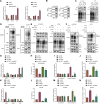Oncogenic microRNA-181d binding to OGT contributes to resistance of ovarian cancer cells to cisplatin
- PMID: 34876558
- PMCID: PMC8651739
- DOI: 10.1038/s41420-021-00715-6
Oncogenic microRNA-181d binding to OGT contributes to resistance of ovarian cancer cells to cisplatin
Abstract
Ovarian cancer (OC), a common gynecological cancer, is characterized by a high malignant potential. MicroRNAs (miRNAs or miRs) have been associated with the chemo- or radiotherapeutic resistance of human malignancies. Herein, the current study set out to explore the regulatory mechanism of miR-181d involved in the cisplatin (DDP) resistance of OC cells. Firstly, in-situ hybridization method was performed to identify miR-181d expression in ovarian tissues of DDP-resistant or DDP-sensitive patients. In addition, miR-181d expression in A2780 cells and A2780/DDP cell lines was determined by RT-qPCR. Gain- and loss-of-function experiments were then performed to characterize the effect of miR-181d on OC cell behaviors. We probed the miR-181d affinity to OGT, as well as the downstream glycosylation of KEAP1 and ubiquitination of NRF2. Further, in vivo experiments were performed to define the role of miR-181d in tumor resistance to DDP. miR-181d was highly expressed in the ovarian tissues of DDP-resistant patients and the A2780/DDP cell line. Ectopic expression of miR-181d augmented DDP resistance in OC cells. In addition, miR-181d was found to target the 3'UTR of OGT mRNA, and negatively regulate the OGT expression. Mechanistic results indicated that OGT repressed NRF2 expression through glycosylation of KEAP1, thereby inhibiting the DDP resistance of OC cells. Furthermore, miR-181d negatively orchestrated the OGT/KEAP1/NRF2 axis to enhance the OC resistance to DDP in vivo. Overall, these findings suggest that miR-181d-mediated OGT inhibition restricts the glycosylation of KEAP1, and then reduces the ubiquitination and degradation of NRF2, leading to DDP resistance of OC. This study provides new insights for prevention and control of OC.
© 2021. The Author(s).
Conflict of interest statement
The authors declare no competing interests.
Figures








Similar articles
-
LncRNA WDFY3-AS2 promotes cisplatin resistance and the cancer stem cell in ovarian cancer by regulating hsa-miR-139-5p/SDC4 axis.Cancer Cell Int. 2021 May 29;21(1):284. doi: 10.1186/s12935-021-01993-x. Cancer Cell Int. 2021. PMID: 34051810 Free PMC article.
-
Circ_0067934 reduces JNK phosphorylation through a microRNA-545-3p/PPA1 axis to enhance tumorigenesis and cisplatin resistance in ovarian cancer.Immunopharmacol Immunotoxicol. 2022 Apr;44(2):261-274. doi: 10.1080/08923973.2022.2038193. Epub 2022 Feb 18. Immunopharmacol Immunotoxicol. 2022. PMID: 35179434
-
miR-133a targets YES1 to reduce cisplatin resistance in ovarian cancer by regulating cell autophagy.Cancer Cell Int. 2022 Jan 10;22(1):15. doi: 10.1186/s12935-021-02412-x. Cancer Cell Int. 2022. PMID: 35012539 Free PMC article.
-
The emerging role of circular RNAs in cisplatin resistance in ovarian cancer: From molecular mechanism to future potential.Noncoding RNA Res. 2024 May 20;9(4):1280-1291. doi: 10.1016/j.ncrna.2024.05.005. eCollection 2024 Dec. Noncoding RNA Res. 2024. PMID: 39040815 Free PMC article. Review.
-
Regulation of Metastasis by microRNAs in Ovarian Cancer.Front Oncol. 2014 Jun 10;4:143. doi: 10.3389/fonc.2014.00143. eCollection 2014. Front Oncol. 2014. PMID: 24959422 Free PMC article. Review.
Cited by
-
The roles of OGT and its mechanisms in cancer.Cell Biosci. 2024 Sep 16;14(1):121. doi: 10.1186/s13578-024-01301-w. Cell Biosci. 2024. PMID: 39285476 Free PMC article. Review.
-
Unraveling role of ubiquitination in drug resistance of gynecological cancer.Am J Cancer Res. 2024 May 15;14(5):2523-2537. doi: 10.62347/WYKZ9784. eCollection 2024. Am J Cancer Res. 2024. PMID: 38859858 Free PMC article. Review.
-
The emerging roles of miRNA-mediated autophagy in ovarian cancer.Cell Death Dis. 2024 May 3;15(5):314. doi: 10.1038/s41419-024-06677-8. Cell Death Dis. 2024. PMID: 38702325 Free PMC article. Review.
-
Role of O-linked N-acetylglucosamine protein modification in oxidative stress-induced autophagy: a novel target for bone remodeling.Cell Commun Signal. 2024 Jul 10;22(1):358. doi: 10.1186/s12964-024-01734-3. Cell Commun Signal. 2024. PMID: 38987770 Free PMC article. Review.
-
Non-coding RNA in cancer drug resistance: Underlying mechanisms and clinical applications.Front Oncol. 2022 Aug 17;12:951864. doi: 10.3389/fonc.2022.951864. eCollection 2022. Front Oncol. 2022. PMID: 36059609 Free PMC article. Review.
References
LinkOut - more resources
Full Text Sources
Miscellaneous

